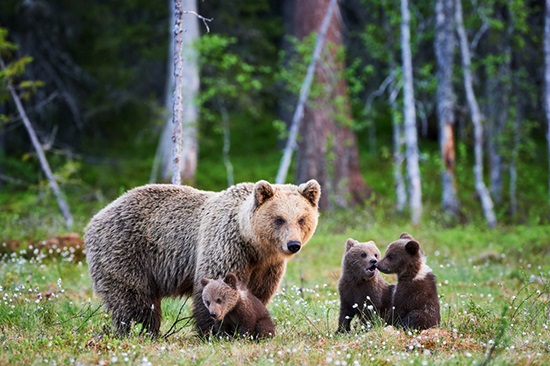Yellowstone’s Grizzlies and Other Wildlife

The grizzly bears of Yellowstone National Park are finally out of danger – at least, according to the U.S. Fish & Wildlife Service. After more than four decades of protection as an endangered species, the park’s most famous residents are set to be de-listed by the end of the summer.
Grizzlies in most U.S. states have been covered under the Endangered Species Act since the 1970s, when the Yellowstone area had a mere hundred or so bears. Today, that number has grown to more than 700. “This achievement stands as one of America’s great conservation successes; the culmination of decades of hard work and dedication on the part of the state, tribal, federal and private partners,” U.S. Secretary of the Interior Ryan Zinke said in a June 2017 press release on the change. “As a Montanan, I’m proud of what we’ve achieved together.”
Grizzlies are among the awe-inspiring wildlife that hikers could spot on a Scenic Safaris summer tour of Yellowstone’s Lower Loop. Go it alone in one of our rental vehicles, or take a guided trip through major features such as Old Faithful, waterfalls, streams and Yellowstone’s Grand Canyon on foot to view a variety of wildlife from small mammals to giant birds of prey.
Curious which animals you might see? Here are a few of the cuddly (and not-so-cuddly) critters you could encounter as you explore the area by ATV, van, raft, or on foot.
Mammals Large and Small
Yellowstone is home to the largest grouping of mammals in the continental U.S. More than 65 unique species have been found here.
Look for:
- Bighorn sheep
- Bison
- Elk and Moose
- Goats
- Deer
- Bears
Even with the increased number of grizzlies at Yellowstone, it’s unlikely that you’ll spot one in the park’s 3,471 square miles. Black bears, on the other hand, are fairly common and less aggressive than their cousins. Coyotes, mountain lions and wolves also roam the park.
Birds
With some 300+ avian species having been spotted at Yellowstone, the park is an excellent place for avid birdwatchers. Many are migratory birds that arrive with the change of season. Note that the use of bird calls in the park is illegal, so keep your interactions limited to observation and picture-taking.
Look for:
- Canadian geese
- Loons
- Golden eagles
- Raptors
- Trumpeter swans
- Osprey
- Falcons
Reptiles & Amphibians
There are six known reptile species and four amphibian types in the park. According to the Centre for Ecological Sciences, the health of an ecosystem can often be determined by its aquatic population. Frogs, turtles and other amphibians control pests and provide food sources for larger animals. They’re also very sensitive to changes in the environment; an increase or decrease in their population can “predict” major ecological shifts.
Look for:
- Chorus frog
- Toads
- Western tiger salamaner
- Rubber boa
- Garter snakes
- Sagebrush lizard
Wildlife viewing is one of the most popular activities in the park. From adorable baby deer to eagles, sheep and frogs, there are plenty of critters to observe in their natural habitats. Whether you’re on foot or in a comfortable luxury van, it’s best to steer clear of wild animals and observe them with the aid of binoculars or a camera. CLICK HERE for information on guided tours of Yellowstone’s diverse wildlife.
